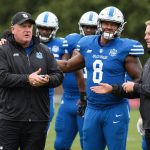Understanding the Needs of Left-Handed Players in Football
Left-handed players in football encounter unique challenges that require targeted attention. Unlike their right-handed counterparts, these athletes often experience a mismatch between their natural instincts and the standard settings of training facilities. Recognizing left-handedness in coaching strategies is crucial, as it can significantly affect a player’s development and performance.
Training regimens often cater predominantly to right-handed individuals, neglecting the specific needs of left-handed players. This oversight can hinder the development of essential skills. For example, practice drills or equipment might not align with a left-handed player’s natural movements, impacting their technique and confidence.
This might interest you : Leveraging Fan Insights: Transforming Match-Day Experiences for Football Clubs
Coaching strategies should incorporate exercises tailored specifically for left-handed players. Coaches need to adopt a flexible approach, ensuring that tactical decisions on positioning and role assignments leverage the strengths of these players. Additionally, providing training materials that acknowledge their distinct grip and handling characteristics can lead to enhanced on-field performance.
Training facilities should also accommodate the needs of left-handed footballers. Modifications to equipment and spatial arrangements can make training more intuitive, helping left-handed players maximize their potential. By understanding and addressing these challenges, the football community can create an inclusive environment that fosters the growth of all players, irrespective of their dominant hand.
Also to discover : Empowering Athletes: Strategies for Football Clubs to Help Players Navigate the Challenges of Professional Sports
Current Practices in Football Clubs
Current practices in football clubs show a growing trend towards incorporating inclusive practices. This shift is, in part, a response to the diverse needs of players, particularly regarding training accessibility for individuals with unique requirements, such as left-handed players.
Case Studies of Progressive Clubs
Several clubs have demonstrated progressive efforts. Arsenal, for instance, has introduced inclusive practices by developing specialized drills that enhance the performance of left-handed players. Real Madrid has invested in modular training programs that prioritize training accessibility for all athletes, incorporating technology to assess and address each player’s individual needs.
Creating Supportive Training Environments
Supportive environments are crucial for fostering inclusivity. To achieve this, clubs like FC Barcelona focus on resource allocation, ensuring training accessibility through adapted equipment and tailored coaching strategies. Such approaches help left-handed players hone their skills without having to conform to right-hand dominant methodologies.
Resources for Coaches
Coaches are pivotal in implementing inclusive practices. By accessing resources such as workshops and training guides, they can learn to tailor techniques, ensuring every athlete feels valued. Recommendations include:
- Developing ambidextrous drills to enhance bilateral coordination.
- Utilizing visual aids that cater to both left and right-handed athletes.
- Encouraging peer support systems that facilitate sharing experiences and strategies within teams.
Strategies for Coaches and Trainers
Coaches and trainers bear the responsibility of nurturing both the skills and inclusive environment for all players, including left-handed individuals. Emphasizing coaching strategies that cater to the unique needs of left-handed players is crucial. Implementing specialized training techniques can harness the potential of these athletes, ensuring their development is on par with their peers.
Recommended Training Methodologies for Left-Handed Players
Proficiency can be enhanced by tailoring specific drills that align with the natural abilities of left-handed players. Coaches should focus on designing exercises that optimize the unique hand movement and spatial orientation of these players. For example, drills that emphasize the use of the left side in games can often yield better adaptability and performance.
Adjustments to Standard Drills
For a truly inclusive coaching environment, adjusting standard drills to consider different aptitudes is indispensable. An inclusive coaching method would involve creating scenarios where left-handed players utilise their dominant side without limitation. This could involve mirrored versions of predominantly right-handed exercises, ensuring balance and fairness in skill development.
Importance of Continuing Education
Diversity in training techniques highlights the need for continuing education for coaches. Understanding diverse training techniques enriches a coach’s ability to foster inclusivity. Through workshops and educational programs, coaches can keep abreast with evolving methods that enhance their effectiveness and inclusivity in sports training.
The Role of Diversity in Player Development
The concept of diversity in football is more than just having players from different backgrounds; it involves a comprehensive approach that enhances overall player performance. When training environments embrace diverse perspectives and techniques, they create opportunities for athletes to learn from one another’s strengths and unique skills.
Benefits of a Diverse Training Approach
Implementing a variety of training methods leads to superior player performance. By introducing players to different playing styles and strategies, coaches can help athletes develop a versatile skill set. This approach not only enhances individual performance but also equips players to adapt to different game scenarios effectively.
Impact on Team Dynamics and Performance
A team enriched with diversity in football experiences improved dynamics and higher coherence. Inclusive training paves the way for a shared understanding among team members, fostering an environment where all players, regardless of their background, feel valued and understood. This inclusive approach often translates to enhanced performance on the field.
Building an Inclusive Sports Community
Promoting an inclusive sports culture fosters unity and respect within football clubs. Clubs that prioritise diversity and inclusion create a welcoming atmosphere, encouraging players from all walks of life to participate. This not only enriches club culture but also supports player development by exposing athletes to a multitude of experiences and viewpoints.











